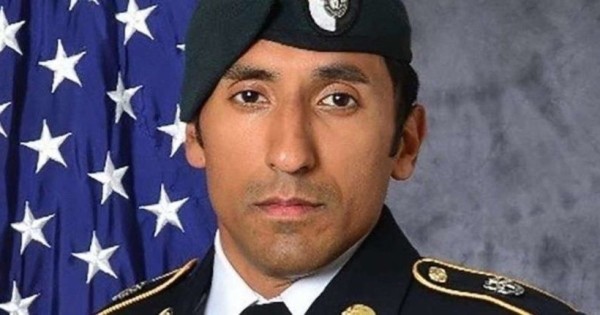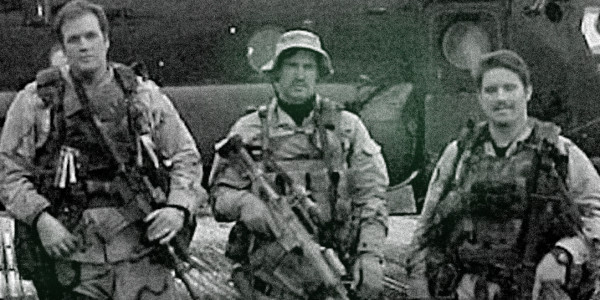The Air Force recognized one of its most elite operators with a Silver Star on Friday for incredible courage under fire during a 2017 mission on the Arabian Peninsula. Master Sgt. Cory Haggett, a pararescueman assigned to the 23rd Special Tactics Squadron, ran back and forth under intense enemy fire to treat four injured comrades while on a night raid deep in enemy territory on January 28, 2017, according to Haggett’s award citation.
Haggett also received a Bronze Star on Friday for his excellent performance on multiple missions in Afghanistan from July 1 to November 1, 2019. Over the course of 56 assault missions, Haggett killed two enemy fighters shooting at him and his comrades from a vehicle; organized and led the medical response plans for the missions, and provided clutch leadership for “partner force members” while under heavy fire, according to his award citation.
Pararescuemen, also called pararescue jumpers or PJs, are elite commandos trained in search-and-rescue and combat medicine. Their two-year training pipeline is among the most difficult in the world since PJs need to be ready to find and save friendly forces stuck in desperate situations. The training paid off that night five years ago, when Haggett, a staff sergeant at the time, put his combat and medical skills to the test.
Haggett was the lead pararescueman for a joint task force that traveled over eight kilometers through difficult terrain to “the set-point,” where the task force immediately took heavy fire “within seventy-five meters in all directions,” the citation said.

While the award citation did not include specifics on the mission objective or who was shooting at Haggett, January 28 happens to be the day before the Raid on Yakla, where U.S. special operators fought at the Yemeni village of Yakla while on a mission to collect documents and electronics on al Qaeda in the Arabian Peninsula, NBC reported in 2017. An official military statement said that raid took place on Jan. 29. The public affairs office for the 24th Special Operations Wing declined to comment on whether the raid Haggett took part in was the Yakla operation.
The Yakla assault force was made up of several dozen U.S. commandos, some of whom were Navy SEALs, and elite soldiers from the United Arab Emirates, according to The New York Times. The commandos learned through a communications intercept that the mission had been somehow compromised, but they pushed on, despite knowing that “they were screwed from the beginning,” a former SEAL Team Six official told The Times.
Subscribe to Task & Purpose Today. Get the latest in military news, entertainment, and gear in your inbox daily.
The commandos got stuck in a 50-minute gunfight with al Qaeda fighters shooting from houses, a clinic, a school and a mosque, where they used women and children for cover, The Times reported. Women also joined in the fighting, so the Americans called in airstrikes and managed to kill about 14 al Qaeda fighters before an MV-22 tiltrotor aircraft came to a “hard landing” injuring three Americans on board. The expensive, heavily damaged aircraft later had to be destroyed in an airstrike. Several civilians and a few children were killed in the fighting, along with Navy SEAL Senior Chief William “Ryan” Owens.
Whether or not Haggett’s raid was the same mission, the airman and his team found themselves in great danger. When a teammate was shot in the chest, the pararescueman went to his aid, dragged him away and shielded the teammate with his own body while giving him medical care under intense fire and “with total disregard for his own life,” the citation said.
Haggett determined that the patient needed an immediate evacuation, so he led four teammates to carry the injured operator 130 meters under “tremendous” small arms fire, the citation said. The pararescueman got a call for help from the rest of the task force, so he sent one of his four guys to help while the rest continued sliding down a “steep and slippery shale-faced mountainside,” to get to the helicopter landing zone.
When they arrived, Haggett performed an expedited cricothyrotomy, making an incision and inserting a tube through the patient’s throat to establish an airway. An emergency cricothyrotomy is “the last resort,” according to trauma medicine experts, and it must have been even more difficult performing the delicate procedure while being shot at. In a show of Air Force pararescue’s intense training, Haggett was able to stabilize the patient until the medical evacuation helicopter arrived. But that was only the start of Haggett’s long day.

Right after the evacuation, the pararescueman ran the 130 meters back up the steep mountainside with bullets hitting the ground around him, the citation said. When he reunited with the task force, another teammate had been injured, so Haggett again “selflessly shielded him with his own body and rendered treatment even while intense small arms fire impacted the area around him.” The team started moving to the exfiltration site, but then a third teammate needed help after sustaining a blunt force trauma wound to the face. Haggett bandaged the wound, which allowed the teammate to keep fighting as the task force pulled back. When they finally made it to the exfiltration site, the pararescueman then treated a fragmentation wound to his troop chief’s arm so that it would not get infected.
Treating four casualties under intense fire stands out even in the Air Force pararescue community, whose motto is “these things we do, that others may live.” The Silver Star is the third-highest U.S. military decoration for valor in combat, but it is only the latest recognition in a 16-year career of distinguished service for Haggett, whose chest is already decorated with a Bronze Star, a Meritorious Service Medal, an Air Medal, a Joint Service Commendation Medal with Combat Device, a Joint Service Commendation Medal with three Oak Leaf Clusters, and an Air Force Commendation Medal with one Oak Leaf Cluster.
The pararescue community is not the only one proud of Haggett’s performance in dire straits. The airman is a hometown hero who went to high school just 20 minutes down the road from Hurlburt Field, Florida, where the 23rd Special Tactics Squadron and the 24th Special Operations Wing are based. The pararescueman is also not the only Haggett in the Air Force: both his mother and father are retired Air Force chief master sergeants and his brother is a CV-22 tiltrotor transport pilot. All three have experience with Air Force Special Operations Command.
Blue, the Air Force color, seems to run in the family, and now add to that a glint of silver.
The latest on Task & Purpose
- The Marine Corps is headed for a pilot exodus
- ‘The king of battle’ — How US artillery in the hands of Ukrainians may reshape the war with Russia
- Marine intel instructors got caught calling students ‘whore’ and ‘slut’ in private chat. No punishment was recommended
- How to pass the new Air Force fitness test, according to a guy who oversaw 600 of them
- ‘Dirt boyz,’ ‘Port Dawgs,’ and ‘Red Horse’ — A guide to Air Force lingo for the rest of us
Want to write for Task & Purpose? Click here. Or check out the latest stories on our homepage.

























